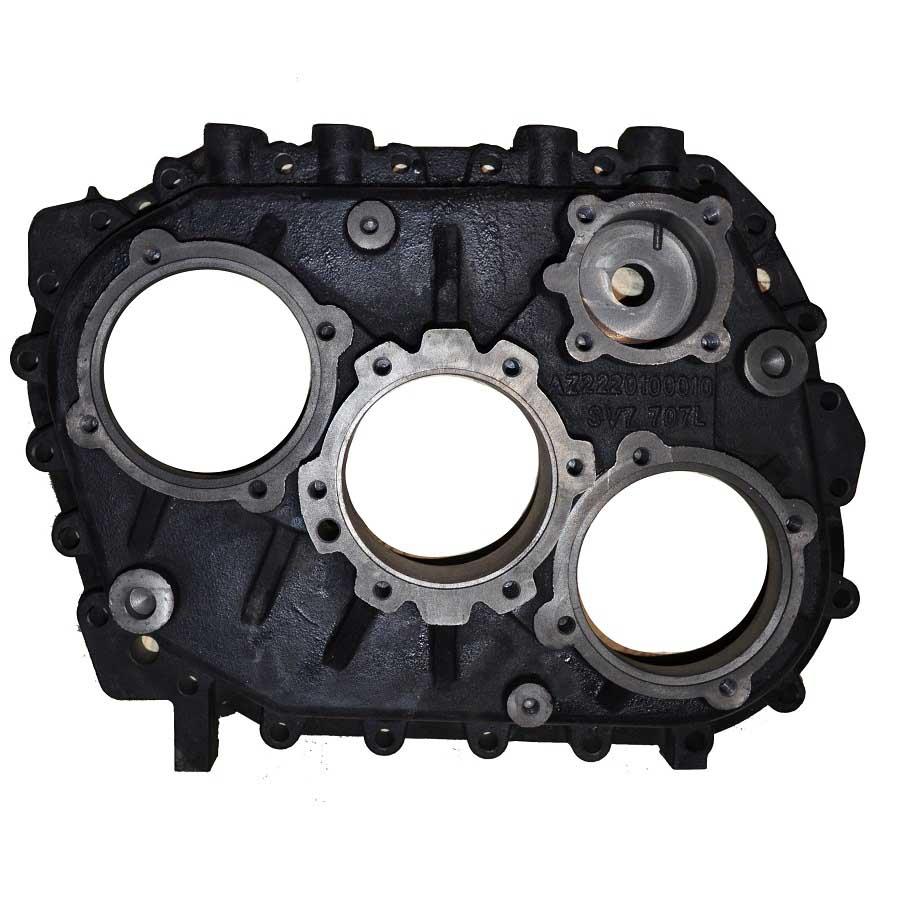
Lost Foam Casting Company
Material: Gray Iron, Ductile Iron, Cast Steel Process: Lost Foam Casting + Machining Weight: 8.70 kg Application: Heavy Truck
China Lost Foam Casting Company with OEM Customized Services.
Description
Lost Foam Casting Company with OEM Customized Services.
Lost Foam Casting vs Vacuum Casting |
||
| Item | Lost Foam Casting | Vacuum Casting |
| Suitable Castings | Small and medium-sized castings with complex cavities, such as engine block, engine cover | Medium and large castings with few or no cavities, such as cast iron counterweights, cast steel axle housings |
| Patterns and Plates | Foam patterns made by moldings | Template with suction box |
| Sand Box | Bottom or five sides exhaust | Four sides exhaust or with exhaust pipe |
| Plastic Film | The top cover is sealed by plastic films | All sides of both halves of sand box are sealed by plastic films |
| Coating Materials | Water-based paint with thick coating | Alcohol-based paint with thin coating |
| Molding Sand | Coarse dry sand | Fine dry sand |
| Vibration Molding | 3 D Vibration | Vertical or Horizontal Vibration |
| Pouring | Negative Pouring | Negative Pouring |
| Sand Process | Relieve negative pressure, turn over the box to drop sand, and the sand is then reused | Relieve negative pressure, then the dry sand falls into the screen, and the sand is recycled |
- Cast Iron: Ductile Iron, Gray Iron, White Iron, Malleable Iron.
- Carbon Steel: AISI 1020 - AISI 1060
- Steel Alloys: ZG20SiMn, ZG30SiMn, ZG30CrMo, ZG35CrMo, ZG35SiMn, ZG35CrMnSi, ZG40Mn, ZG40Cr, ZG42Cr, ZG42CrMo...etc on request.
- Stainless Steel: AISI 304, AISI 304L, AISI 316, AISI 316L and other stainless steel grade.
- Brass & Copper.
- Other Materials and Standards on request
▶ Capabilities of Lost Foam Casting
- Max Size: 1,000 mm × 800 mm × 500 mm
- Weight Range: 0.5 kg - 100 kg
- Annual Capacity: 2,000 tons
- Tolerances: On Request.
▶ Inspecting Lost Foam Castings
- Spectrographic and manual quantitative analysis
- Metallographic analysis
- Brinell, Rockwell and Vickers hardness inspection
- Mechanical property analysis
- Low and normal temperature impact testing
- Cleanliness inspection
- UT, MT and RT inspection
▶ The general lost foam casting process are as in the following:
- Use foam molds to produce foam patterns and casting gating systems
- Bond the patterns and runners to form a mold bundle module
- Dip paint on the module with refractory materials
- Dry the paint
- Put the module into the sand box and fill it with dry sand
- Vibrate molding in order to fill the cavity with dry sand and then compact the molding sand
- Pouring molten metal to vaporize the foam and then forming the desired castings
- After the castings have cooled, clean the castings. The dry sand can be recycled
▶ Post-Casting Process
- Deburring & Cleaning
- Shot Blasting / Sand Peening
- Heat Treatment: Normalization, Quench, Tempering, Carburization, Nitriding
- Surface Treatment: Passivation, Andonizing, Electroplating, Hot Zinc Plating, Zinc Plating, Nickel Plating, Polishing, Electro-Polishing, Painting, GeoMet, Zintec.
- CNC Machining: Turning, Milling, Lathing, Drilling, Honing, Grinding.
▶ Why You Choose RMC for Custom Lost Foam Casting Parts?
- Full solution from one single supplier ranging customized pattern design to finished castings and secondary process including machining, heat treatment and surface treatment.
- Costdown proposals from our professional engineers based on your unique requirement.
- Short leadtime for prototype, trial casting and any possible technical improvement.
- Bonded Materials: Silica Col, Water Glass and their mixtures.
- Manufacturing flexibility for small orders to mass orders.
- Strong outsourcing manufacturing capabilities.
▶ General Commerial Terms
- Main workflow: Inquiry & Quotation → Confirming Details / Cost Reduction Proposals → Tooling Development → Trial Casting → Samples Approval → Trial Order → Mass Production → Continuous Order Proceeding
- Leadtime: Estimatedly 15-25 days for tooling development and estimatedly 20 days for mass production.
- Payment Terms: To be negotiated.
- Payment methods: T/T, L/C, West Union, Paypal.
 русский
русский



